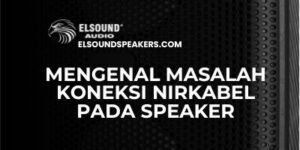Have you ever been singing or enjoying music through your wireless speaker - Bluetooth, Wi-Fi, or any other wireless connection - when suddenly the sound cuts out, even though the connection indication seems stable? Frustrating, right? In this article, we'll explore the technical and non-technical causes of the problem - and most importantly: what are the practical solutions to make it happen? Active Speaker Can Karaoke, Best Karaoke Bluetooth Active Speaker, Active Speaker Can Make Karaoke, even Active Speakers Great for Karaoke You can be loud again, without interruption.
We'll break down the solutions for various situations, including when you're using 15 Inch Small Watt Speaker, Small 18 In Watt Speaker, or 18 Inch Small Watt Speaker. And yes, if you're looking for a trusted audio provider, I'll also interject how Elsound Speaker & Audio could be the answer at your fingertips. Let's start the journey of restoring clarity to your wireless sound!
Why is Wireless Voice Intermittent Despite a Stable Connection?
Before getting into the solution, we must first understand why the problem occurred. Here are some common causes:
- Frequency interference
Although the connection "looks" stable, radio frequencies can overlap. There are other devices nearby (Wi-Fi routers, microwaves, other wireless devices) that use 2.4 GHz or 5 GHz frequencies and thus interfere with each other. - Distance and physical barriers
Even if the signal is strong, if there are many walls, large furniture or metal objects between the transmitter and receiver, the signal may be weakened or reflected. - Quality of Bluetooth module/wireless receiver
The speaker or receiving device may be using a cheap Bluetooth module, or the firmware may not be optimized, causing "dropouts". - Source device (e.g. HP/laptop/mixer) is overloaded
If the audio source is overloaded with many processes, or there are other applications that prioritize the network, Bluetooth transmission may be interrupted. - Power supply faults
If your wireless speaker uses an adapter or batteries, power fluctuations may affect the stability of the wireless module inside the speaker. - Codec or bit rate not matching / transmission overload
If you play high quality audio (high bit rate), sometimes the device is not able to transfer data continuously without buffering or pausing. - Outdated firmware or drivers
Active speakers, or source devices (e.g. smartphones/laptops), could have bugs that cause dropouts on older firmware or driver versions.
Knowing these causes is important so that the solutions we choose are not "off the cuff" - we'll tailor them to your own situation. Now let's talk about ways to solve it.
1. Optimize Location and Distance: Minimize Obstructions & Interference 🧭
We start with the simplest and most overlooked aspect: physical placement. In an audio environment, a slight change in position can have a big impact.
1.1 Keep a close distance and direct view
Ensure that the transmitting device (cell phone, mixer, Bluetooth dongle) and wireless speaker are in the same effective distance (e.g. <10 meters depending on specifications). Try to have them "see" each other directly without many walls or metal barriers in between. Minimize obstructions such as iron cabinet, refrigerator, or iron pole.
1.2 Avoid sources of interference
Place the speaker and sending device away from Wi-Fi routers, microwaves, other wireless cameras, baby monitors, and other equipment that emits radio waves. If possible, use different Wi-Fi channels or move the routers out of frequency proximity.
1.3 Use bluetooth extension/repeater
If your room is large, consider using Bluetooth repeater range extender or a more powerful external wireless module (such as a high-end Bluetooth module). Ensure that the repeater is compatible with your active speaker.
2. Device & Firmware Upgrade: Ensure High Quality Wireless Module
If the positioning is optimized but the problem still arises, the weak point may be in your wireless module or device firmware.
2.1 Use active speakers with high quality Bluetooth/wireless modules
Not all 15 Inch Small Watt Speaker or 18 Inch Small Watt Speaker equipped with a reliable wireless module. Some cheap types do sacrifice the quality of the Bluetooth module to be cheap. If you want an uninterrupted wireless experience, consider active speaker types that are designed with quality wireless modules and good internal antennas.
For example, active speakers that support the latest version of Bluetooth (5.x) or Wi-Fi high-fidelity audio are more capable of handling data stably.
2.2 Firmware/driver updates
Check that your active speaker - or external Bluetooth module - has an official firmware update from the manufacturer. The same goes for the source device (mobile phone, laptop) - make sure your Bluetooth driver or operating system is up to date. Bugs fixed in updates can eliminate dropouts.
2.3 Setting codec & bit rate
Some devices give the option of selecting the codec (SBC, AAC, aptX, etc.) and maximum bit rate. If the bit rate is too high, try lowering it to avoid overloading the transmission path. If the speaker and sender support a more efficient codec (such as aptX Low Latency), enable it for better synchronization and stability.
2.4 Check internal/external antenna
Sometimes the quality of the antenna (shape, position, cable) determines the signal strength. If possible, open the speaker cover (if safe to do so) and check if the antenna connection is good. For modified or DIY active speakers, you can add an external antenna or a short coaxial cable to amplify the signal.
3. Audio & Power Source Management: Ensure Optimal Performance
If your physical and hardware connections are optimized but you're still experiencing frequent disconnections, this part is most likely to blame - especially if you're using active speakers in a karaoke or small band configuration.
3.1 Unload the source device
Ensure that the source device (e.g. laptop or smartphone) is not running many heavy applications that access the network or high resources. Close background apps that may interfere with the Bluetooth connection.
3.2 Use an audio buffer or player app with stable settings
Some music player apps allow setting a buffer or "low latency" mode. Enable that mode for more stable continuous transmission.
3.3 Ensure that the speaker power supply is stable
If the speaker is powered by a mains adapter, ensure that the mains voltage is stable (use a stabilizer if necessary). If the speaker is using batteries, ensure that the batteries are in top condition - low batteries may cause the wireless module to lose power momentarily.
3.4 Safety/power-saving mode
Some speakers or source devices have a "power-saving" or "sleep mode" setting that turns off the wireless module when it has been inactive for a few seconds. Turn off this mode to keep the module active. Likewise, on a mobile phone or laptop, turn off the battery saving mode that prioritizes power saving over the Bluetooth connection.
3.5 Check router configuration (if using Wi-Fi)
If your active speaker is a Wi-Fi speaker or uses a local network (e.g. AirPlay, DLNA, or third-party apps), make sure your router supports wide band and QoS (Quality of Service) for audio data prioritization. Allocate dedicated bandwidth so that audio transmissions are not interrupted by streaming videos or torrents.
Case Examples & Solutions by Speaker Type
To make things easier, let's discuss specific solutions to speakers with certain characteristics - 15 Inch Small Watt Speaker, 18 Inch Small Watt Speaker, and a Bluetooth-enabled speaker for karaoke or electric guitar use.
4.1 For 15 Inch Small Watt Speaker (wireless)
- Since the wattage is small, the wireless modules included are usually not very high-end either. Make sure:
- The distance between devices is close (e.g. <5-7 meters) without major obstacles.
- Do not use excessive codecs or bit rates.
- If possible, add a more powerful external Bluetooth dongle near the speaker.
- Ensure that the speaker power adapter does not produce electrical noise that interferes with the wireless module.
- The distance between devices is close (e.g. <5-7 meters) without major obstacles.
4.2 For 18 Inch Small Watt Speaker (wireless)
- 18-inch speakers are usually used for big bass, so the main challenge might be the larger physical structure - perhaps more metal frame, more complex internal space. The solution:
- Place the wireless module in the "more open" position so that the antenna is not obstructed by the metal chassis.
- Use an antenna extension cable (if possible) to get the antenna out of congested spaces.
- Update the firmware regularly so that the module handles large data transmission better.
- Use the efficient codec mode to avoid overburden.
- Place the wireless module in the "more open" position so that the antenna is not obstructed by the metal chassis.
4.3 For Karaoke / Guitar / Bluetooth Active Speaker
Now, this is the domain that is most often used in real applications:
- Active Speaker Can Karaoke / Active Speaker Good For Karaoke / Best Karaoke Bluetooth Active Speaker / Best Bluetooth Active Speaker For Karaoke:
Make sure your active speakers support karaoke mode (mic input + mix)There are active speakers that feature echo, equalizer, and microphone delay - choose a stable one. There are active speakers that feature echo, equalizer, and microphone delay - choose a stable one. - Active Speaker for Electric Guitar:
For guitars, latency (delay) is the main enemy. Make sure the Bluetooth module/line input in the speaker has very low latency. If necessary, a wired connection is safer (guitar jack to active speaker input line). If you want a wireless guitar, use a (dedicated) wireless guitar system instead of regular Bluetooth for less latency. - If you're experiencing intermittent sound when your active speaker is ideal for karaoke or guitar - chances are the problem falls on interference, distance, low-grade Bluetooth modules, or firmware - go back to points 1, 2, 3 above.
Practical Steps to Deal with Disjointed Voice (Checklist)
Below is a structured checklist so you can quickly check and fix the problem:
Step | What to Check/Do | Important Notes |
1 | Physical distance & position | Bring the transmitter closer to the speaker, removing large obstructions |
2 | Avoid interference | Keep away from routers/microwaves/other wireless devices |
3 | Codec / bit rate | Lower the bit rate or enable efficient codecs (if available) |
4 | Firmware & driver updates | Check speaker and sending device updates |
5 | Stable power supply | Use a stabilizer, make sure the speaker battery is strong |
6 | Turn off power saving mode | Make sure the wireless module is not "auto sleep" |
7 | Add repeater/external antenna | If the distance is long or there are many obstacles |
8 | Network priority (Wi-Fi) | If using the Wi-Fi protocol, set the QoS |
9 | Check the Bluetooth speaker module | If the module is low grade, consider upgrading or replacing the unit |
10 | Testing & monitoring | Test under various conditions (distance, source, codec) to ensure stability |
By following this checklist one by one, you can sharpen your diagnosis, narrow down the possible causes, and then implement the right solutions. Let's look at the narrative of how you can do this in practice.
Practical Narrative - Solving Intermittent Wireless Voice Problems
Imagine you have Best Karaoke Bluetooth Active Speaker (Let's say a mid-range model from a trusted brand). You're hosting a small karaoke event in your living room. All is well at first, but after a while the sound of the backing track suddenly "stutters" or gets intermittent even though your phone shows that the speaker is still connected to Bluetooth.
Step A: Location & Interference Check
You notice that the Wi-Fi router is right between your phone and the speaker. That's right, your 2.4 GHz router is active and "clashing" frequencies. You move the speaker a little to the side, or move the phone so that the line of sight is wider. Suddenly, the sound is smooth again.
Step B: Check Codec & Bit Rate
It turns out that the player app (e.g. karaoke app) on your phone is set to a high bit rate. You go to the app's settings, lower the audio quality, or select "low latency" mode if available. The effect: lighter, more stable transmission.
Step C: Check Firmware & Drivers
You check the speaker manufacturer's website, and it turns out that there is a recent firmware update intended to fix the Bluetooth connectivity issue. You download and perform the update. After a restart, the sound dropouts are much reduced, if not completely gone.
Step D: Power Supply & Save Mode
You check the speaker adapter: it turns out that cheap adapters produce occasional electrical noise, which "interferes" with the module signal. You change to a better quality adapter, or connect it to an electrical stabilizer. Also make sure the speakers are not in "sleep" mode - turn off the power saving feature in the speaker system menu.
Step E: If the Room is Large - Add a Repeater
The karaoke event moves to a large room space or small hall. The distance between the phone and the speaker reaches ~12 meters with a wall in between. You install Bluetooth range extender in the center of the room (5-6 m from the phone, 5-6 m to the speaker). The extender module absorbs the signal from the phone and passes it to the speaker. Voila: stable sound again.
Step F: Alternative Wired / Dedicated Wireless System
If you still get interference, and your karaoke app supports it, you can use a direct audio cable (line in) or use a dedicated professional wireless system (for microphone/guitar) that has ultra-low latency. The cost is higher, but the convenience of stability is "peace of mind."
If all of the above steps have been tried but there is still an intermittent "little gap", there could be a hardware defect in your speaker's Bluetooth module, and the solution may be to replace the module unit (if possible) or even change the speaker to a series that is intended for superior wireless performance.
Additional Tips for a More Robust Wireless Connection
- Use a sender/receiver device that supports Bluetooth 5.x or the latest technology (has better coverage and less interference)
- Where possible, use Wi-Fi Audio protocol (miracast, AirPlay, DLNA) if speaker supports - sometimes more stable than Bluetooth
- Activate QoS (Quality of Service) on the router for high-priority audio traffic
- Use electrical shielding or high-quality cables so that electrical noise does not spread to the wireless module.
- Don't move around the room too much during use - the more you move around, the more likely it is that a Bluetooth "re-search" could cause a drop.
- Test the minimum to maximum distance to find your speaker's "safe radius"
- Note the time patterns of when it disconnects - e.g. when many people are using Wi-Fi, when other devices are on, etc. - so that you can avoid those conditions.
Also read the article below
Isolation Technique: Eliminating Annoying Speaker Vibration - Elsound Audio
Why Choose Elsound Speaker & Audio?
When you want practical and reliable solutions, theory isn't enough - you need real products and support. This is where Elsound Speaker & Audio is here as your trusted voice partner. Here's why you can rely on them:
- Quality products: ESound provides a range of active speakers, Bluetooth speakers and professional audio devices designed for high performance, including karaoke and wireless use.
- Consultation service: Their team is ready to help you choose Active Speakers Great for Karaoke, or choose an ideal size such as 15 Inch Small Watt Speaker, 18 Inch Small Watt Speakeror other models based on space and power requirements.
- After-sales support: ESound's warranty, service and firmware updates ensure your product remains optimized.
- Easy contact: You can contact Elsound Speaker & Audio through their website at elsoundspeakers.com, or directly through the number 0851-7988-9353 for consultation and booking.
So if you're looking to buy an active speaker that's truly ready for wireless karaoke, or want a Bluetooth module/repeater upgrade solution, ESound could be a solid starting point.
Conclusion & Call to Action
Wireless connections that are "intermittent" even when they seem stable can be annoying, especially when you want to karaoke or enjoy your music without a hitch. However, with the structured analysis and practical steps we have discussed - from placement, interference, hardware upgrades, audio source settings, power management, to the use of repeaters - you can minimize (or even eliminate) the interference.
For your application:
- If you have 15 Inch Small Watt Speaker or 18 Inch Small Watt SpeakerMake sure the wireless module is good enough or ready to be upgraded.
- If your goal is karaoke, select Active Speaker Can Karaoke / Active Speaker Good For Karaoke / Best Karaoke Bluetooth Active Speaker / Best Bluetooth Active Speaker For Karaoke which features mic input, echo, and low latency.
- For electric guitars, it is safer to use a wired connection or a dedicated wireless system for minimal latency.
And when you're ready to buy or upgrade, remember: Elsound Speaker & Audio is a local resource that can help you choose the ideal unit and after-sales service. Contact them at elsoundspeakers.com or 0851-7988-9353.
Hopefully, this article has enlightened you and provided real solutions. Make music without distractions-because your voice deserves to be enjoyed with clarity and passion!
Read the rest of the article below:
https://elsoundspeakers.com/category/artikel/





